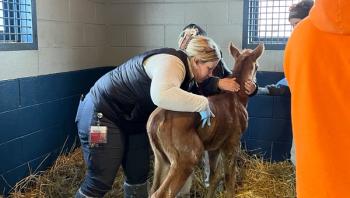
Oregon veterinarians tally retail pharmacists' mistakes
Survey reveals dosage changes, product substitutions that have harmed pets.
The Oregon Veterinary Medical Association (OVMA) recently conducted a survey to determine how often mistakes are occurring when retail pharmacies fill veterinary prescriptions. The results indicate that these errors are not isolated incidents—in fact, they’ve been observed by more than a third of veterinarians in the state.
In the October 2012 issue of Viewpoint, the OVMA’s quarterly newsletter, the organization reports that 35 percent of respondents had had a retail or online pharmacy change a prescribed dosage or medication without their authorization. What’s more, 17 percent have had patients experience adverse events as a result of these types of changes.
The OVMA also asked for examples of cases in which patient health suffered because of a retail or online pharmacist’s error. Here are some of the areas where Oregon veterinarians are seeing problems:
• Insulin substitutions. Many respondents have experienced a retail pharmacist substituting one insulin product for another to save the client money, believing the products were interchangeable, the OVMA report says. As a result, one patient experienced diabetic ketoacidosis and others received subtherapeutic treatment until a veterinarian discovered the problem on recheck.
• Thyroid drug dosage changes. Retail pharmacists also sometimes lower thyroid medication dosages for pets without consulting the prescribing veterinarian. “Evidently, the retail pharmacists are equating an animal’s ability to absorb and metabolize the medication in the same manner as a human,” the report states. “There are distinct differences.”
• Phenobarbital dosage changes. One veterinarian diagnosed epilepsy in an older dog and perscribed 15 mg of phenobarbital twice daily. The dispensing pharmacist told the client that the dosage was too high and advised her to cut it in half. The dog continued to experience seizures for several weeks, until the veterinarian discovered the problem during a recheck. The dog was euthanized.
• Ringworm treatment substitutions. Another veterinarian prescribed itraconazole to treat ringworm in a cat. The retail pharmacy did not carry the prescribed medication, so it dispensed a compounded product that’s “unreliable and poorly absorbed in cats,” the report says. The treatment failed. The ringworm later responded to terbinafine.
• Acetominophen unawareness. One practitioner prescribed Hycodan tablets (hydrocodone bitartrate and homatropine) as a cough suppressant for a patient with a collapsed trachea. The pharmacy did not carry the product and so substituted hydrocodone with acetominophen. “Fortunately the prescription was for a dog and not a cat,” the OVMA says in its report. “High dosages can cause irreversible liver damage [in dogs]. There are no safe dosages for cats.” In a separate case, a client asked a pharmacist what she could do to relieve her dog’s arthritis pain, and the pharmacist recommended high doses of Tylenol.
• Propylene glycol misinformation. A veterinarian prescribed propylene glycol for a Labrador retriever with a hyperkeratotic nose problem. The dog’s owner refused to have the prescription filled when the retail pharmacist told her that the veterinarian had prescribed antifreeze (ethylene glycol), which would kill the dog. The veterinarian discovered this when she called the client for a progress report.
• Wrong drug dispensed; wrong drug recommended. A dog with autoimmune disease was to be treated with the chemotherapy drug azathioprene. Instead, the retail pharmacist dispensed azithromycin. The patient relapsed and had to be euthanized. The same veterinarian was treating another autoimmune patient that was experiencing alopecia. “The client happened to be at a local pharmacy and mentioned the hair loss to the pharmacist, who suggested that she purchase Rogaine,” the report says. “Minoxidil is the active incgredient in Rogaine and can cause cardiomyopathy in dogs—something the pharmacist did not know.”
• Incorrect client instructions. A veterinarian who diagnosed atypical mycobacterium in a cat prescribed a liquid antibiotic for the client to have filled at a nearby pharmacy. The retail pharmacist gave the client “significantly incorrect” dilution instructions. The patient relapsed and was euthanized.
• Incorrect dosages. At his client’s request, a veterinarian called in a perscription to a local pharmacy. The pharmacist filled the prescription at 10 times the correct dose. Several refills were called in, and each time the medication was dispensed at 10 times the correct dose. While the patient was receiving this dosage, other medical and behavioral problems emerged. The veterinarian tested the patient extensively before discovering the problem, and the client had to pay significant medical fees as a result.
• Disregard for veterinarians’ instruction. Respondents indicated that many retail pharmacists changed dosages or medications even when the prescription read, “No substitution.”
• Refill authorization problems. Veterinarians have also had problems with pharmacists who fax a “refill authorization” with incorrect or incomplete instructions. When the veterinarian hand-corrects the form and faxes it back to the pharmacy, the pharmacist tends to not correct the label.
• Inappropriate client counseling. Many practices have had clients frightened out of having prescriptions filled after pharmacists have explained a particular drug’s human side effects, even though the noted side effects do not occur in animal patients.
“Given what we’ve learned,” says OVMA Executive Director Glenn Kolb, “we’re suggesting that veterinarians sharpen their counsel and communications with clients. They could say, ‘If a pharmacist suggests changing to a different drug or different dosage, please contact me right away.’”
Kolb says other state veterinary medical associations, including those in Iowa, Washington, Georgia, Arizona, Pennsylvania and Minnesota, have conducted similar research among their members or are considering it. “When a pharmacist counsels clients or makes changes to a prescription beyond the scope of their expertise, they’re in violation of their state practice act,” Kolb says. “We want to make sure that if pharmacists have any questions, they contact the veterinarian.”
Newsletter
From exam room tips to practice management insights, get trusted veterinary news delivered straight to your inbox—subscribe to dvm360.






